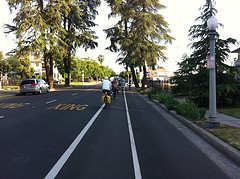
flic.kr/p/9FdZmb
There are four requirements for safe cycling: physical strength, ability to handle the bike expertly, knowledge of routes, and knowledge of traffic laws. Each of these requires additional effort on the part of the cyclist. But these are skills that will stand him in good stead in the long run.
1. Building cycling strength: Physical exercises like jogging, skating or walking alone are not enough for the cyclist. Yes, they do build muscular strength but the cyclist also needs strong calf and thigh muscles. For this, the cyclist have to cycle on rough terrains, especially mountain trails. The cyclist also needs to pedal long distances to help his body get used to strain. A good policy is to ride a comfortable distance daily, and taking care to increase this distance gradually.
2. Improving handling skills: Efficient cycling requires proper handling of the cycle and quick responses. A cyclist must learn how to ride in a straight line, look back while riding, mounting or dismounting. He must also learn how to stop suddenly at traffic lights, avoid obstacles like holes, stones, ditches. Similarly, he must learn how to swerve or take sharp turns without falling. The best way to be familiar with these skills is to practice them in empty parking lots, deserted lanes or cycling tracks.
3. Rules for safety: The best way to ensure safety is to obey traffic laws, be alert, wear light colored clothes for visibility, take the less travelled route and keep the bike, especially the brakes, in good working condition. Use of helmets, bells, and night-lights, riding on bike paths, and keeping to the lane increase the security of both the cyclist and the pedestrians.
4. Keeping alert: It pays to be alert and vigilant, and ready to brake or swerve when encountering an unexpected obstacle.
|
Learn how to ride faster than you ever thought possible |
5. Taking the less travelled road: Cycling on the less travelled road not only makes the ride enjoyable but also less strenuous as well as safe. If there is less traffic, the cyclist can speed up if the weather is good or if he is in a hurry. This is not possible on high density traffic routes, where there is always a risk of collision.
6. Always keep the bike in good repair: A cyclist must always take good care of his bike. He must ensure that the brakes are properly adjusted, the wheel alignment is correct, the handlebars are securely fastened and the seat is comfortable and at the right height.
Tagged with: biking tips • safety gear
Filed under: Bikes